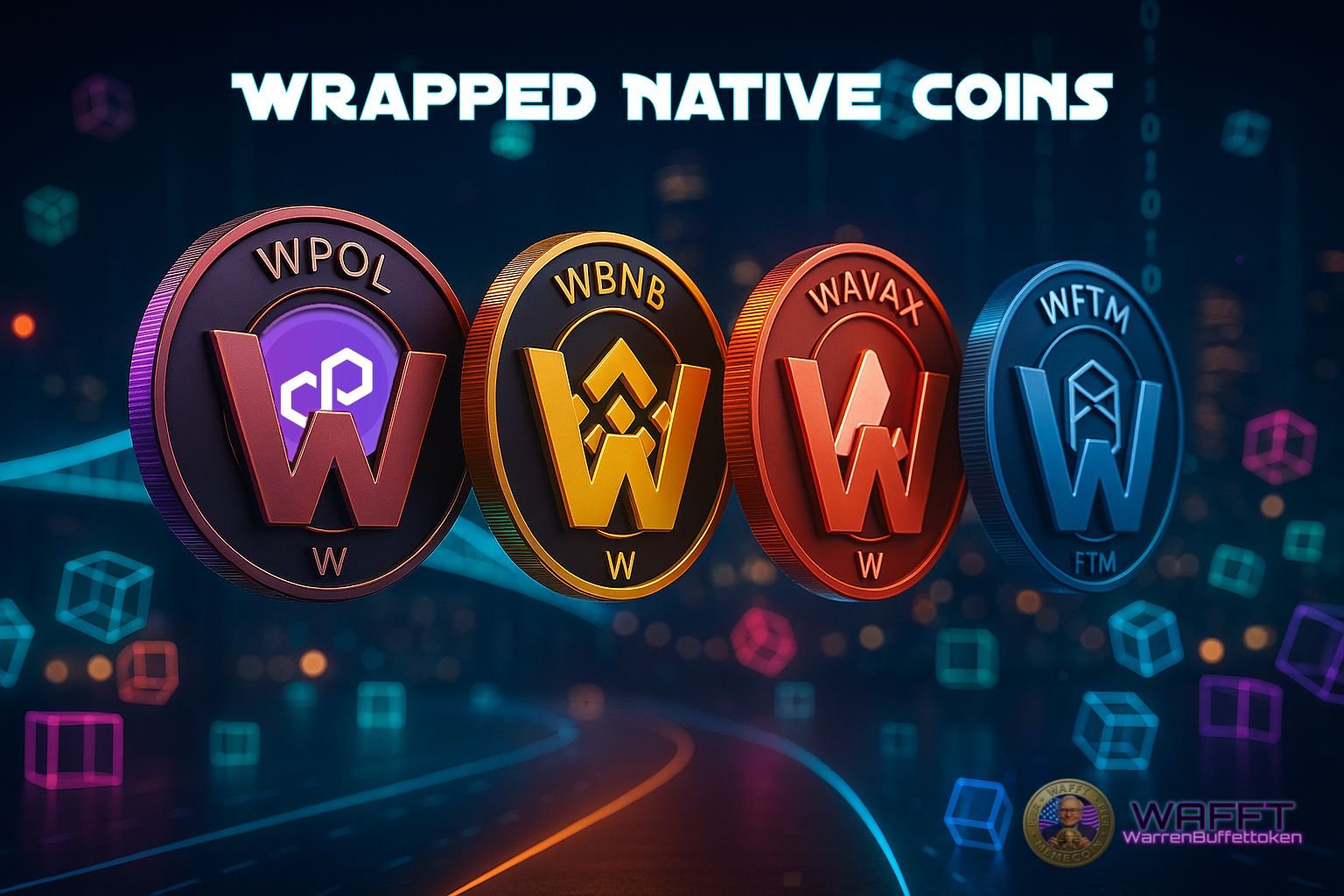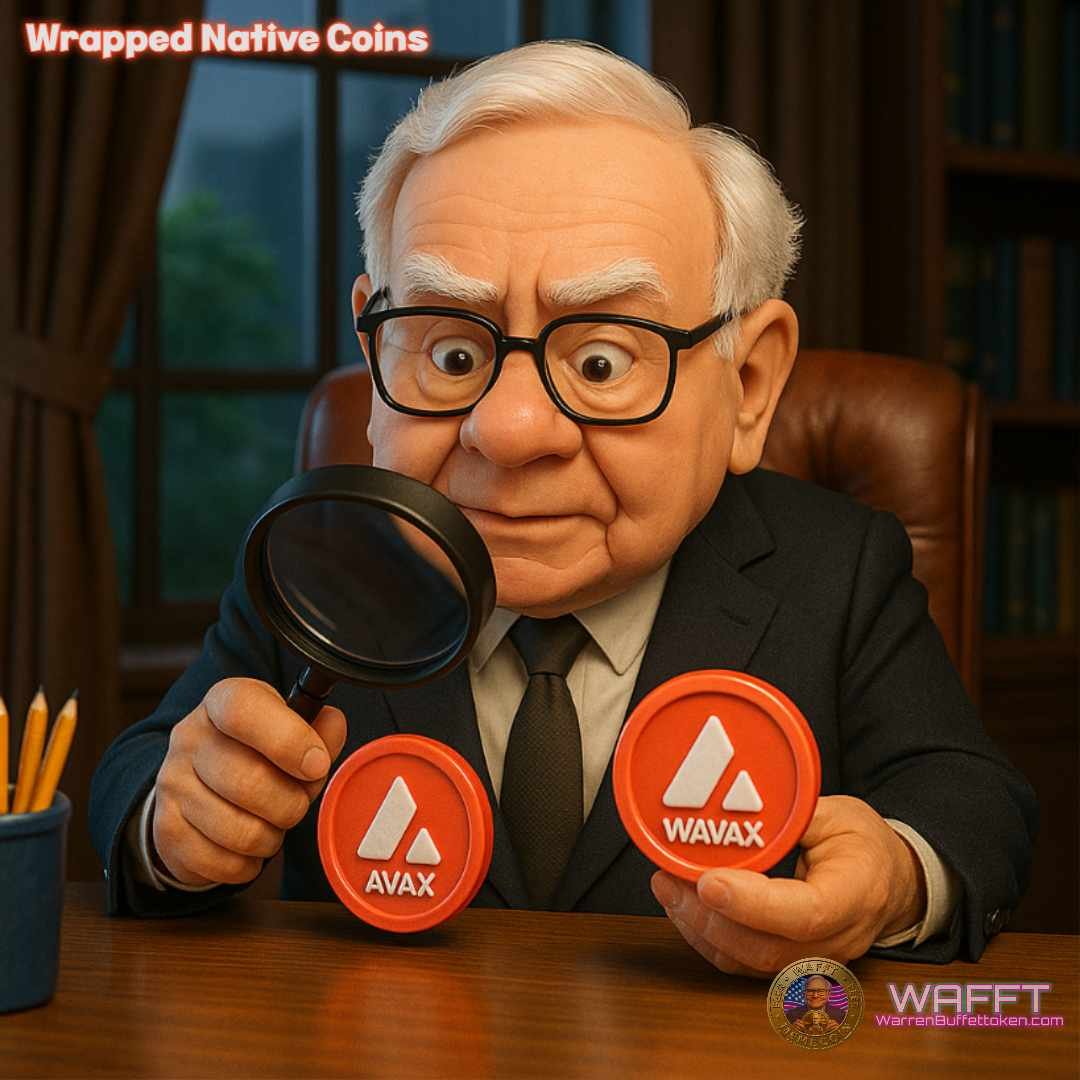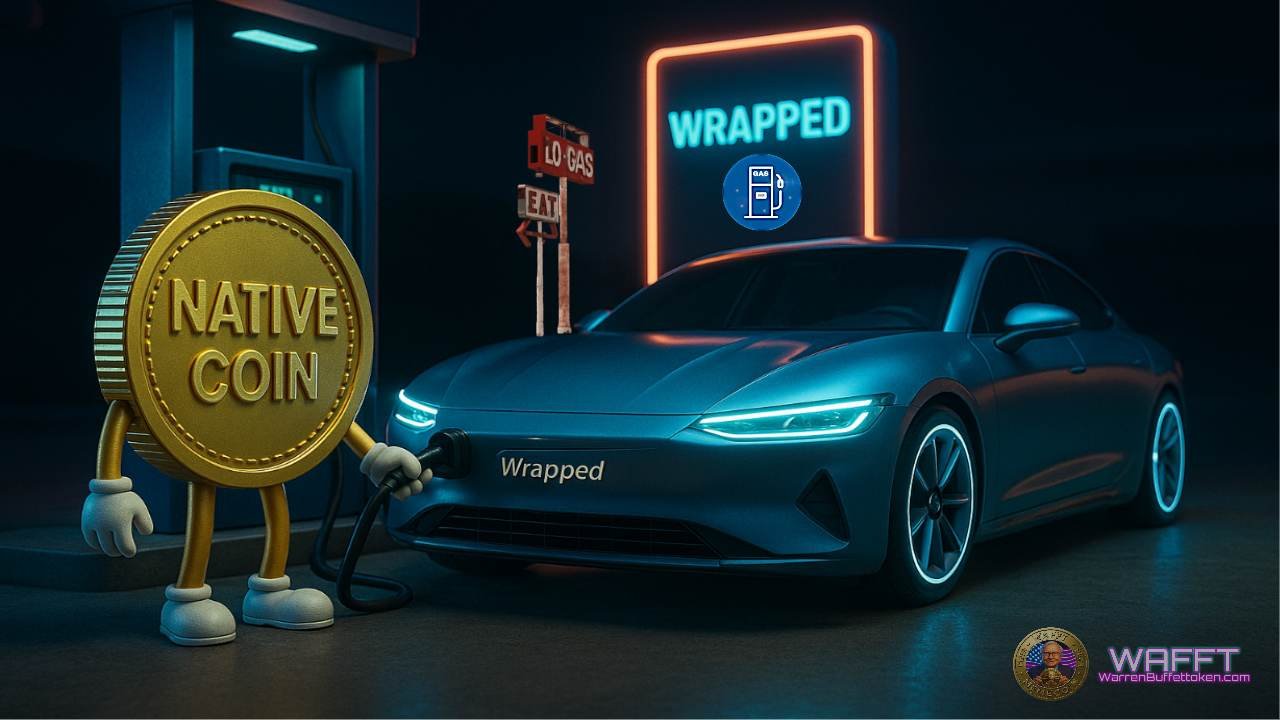WPOL / WBNB / WAVAX / WFTM — Wrapped Native Coins

🧐 What they are:
- 🪙 Native coin vs. standard token: Each network has its “home coin” to pay gas (POL on Polygon, BNB on BNB Chain, AVAX on Avalanche, FTM on Fantom). Those coins don’t always “speak” ERC–20/BEP–20 (no approve / transferFrom).
🔁 Wrap: You deposit the native coin into a contract and receive its wrapped version 1:1:
1 POL → 1 WPOL · 1 BNB → 1 WBNB · 1 AVAX → 1 WAVAX · 1 FTM → 1 WFTM.
(Think of an ERC–20/BEP–20 “suit” that makes it compatible with all dApps.)🔄 Unwrap: You return the wrapped token and the contract gives you back the native coin 1:1.
🧩 Why they exist (in one line): So the native coin becomes a standard token and can be used in dApps that require ERC–20/BEP–20 (later in “How it works/Use it for” we’ll go into detail).
🧭 What they are NOT: They’re not bridges or synthetics from another network: each wrapped token redeems 1:1 on its own chain.
🧮 Decimals: Typically 18 on these EVM networks (same “number of decimals” as many ERC–20s).
- 📍 Where they live: Each network has its own contract (different address). We’ll add canonical contracts later; for now, keep the idea: same logic, different address per chain.
Quick mini-example ⚡:
You have 2 AVAX and a dApp asks for “WAVAX”: you wrap → you receive 2 WAVAX. Later, you don’t need it: you unwrap → you’re back to 2 AVAX. Simple.

Mini-glossary 📚:
🔸 ERC–20 / BEP–20 — Technical standards (with functions such as approve/transferFrom) that act as the “common language” understood by wallets, exchanges, and dApps to handle tokens safely and consistently on their respective chains (Ethereum and BNB Smart Chain (BSC)).
💡 WAFFTip: When you see “W_WHATEVER,” think: “it’s the network’s coin in a standard suit for DeFi.”
At WAFFT we use it this simply: native for gas, wrapped for dApps. And we always confirm the contract address in the block explorer. 🚀


🧠 WAFFT flow: Do you need to use a dApp?
1. Verify the official contract of Wrapped [Coin] in the block explorer.
2. Wrap only the amount you need for the operation.
3. Interact with the dApp.
4. Unwrap the leftover back to native. Easy and safe.
🔑 Key facts:
Polygon PoS — WPOL
🔢 Decimals: 18
🧾 Canonical contract (Polygon PoS):
0x0d500B1d8E8eF31E21C99d1Db9A6444d3ADf1270— (always verify the full checksummed contract address before interacting).Refs: Polygonscan — WPOL token / Polygonscan
BNB Chain — WBNB
🔢 Decimals: 18
🧾 Canonical contract (BNB Chain):
0xBB4CdB9CBd36B01bD1cBaEBF2De08d9173bc095c— (always verify the full checksummed contract address before interacting).Refs: BscScan — WBNB token / BscScan
Avalanche C-Chain — WAVAX
🔢 Decimals: 18
🧾 Canonical contract (Avalanche C–Chain):
0xB31f66AA3C1e785363F0875A1B74E27b85FD66c7(always verify the full checksummed contract address before interacting).Refs: Snowtrace — WAVAX token / Snowtrace
Fantom Opera — WFTM
🔢 Decimals: 18
🧾 Canonical contract (Fantom Opera):
0x21be370D5312f44cB42ce377BC9b8a0cEF1A4C83— (always verify the full checksummed contract address before interacting).Refs: Fantom Explorer / CoinGecko — Wrapped Fantom / OKLink — address
🛠️ How it work:
- 🔁 Wrap (deposit): You typically call
deposit (payable): you send the network’s native coin (e.g., POL on Polygon, BNB, AVAX, FTM)and the contract mints its wrapped version 1:1 (→ WPOL, WBNB, WAVAX, WFTM) to your address. - 🔄 Unwrap (withdraw): You call
withdraw (amount): the contract burns that amount of wrapped and sends you the native coin 1:1 to the same wallet that made the call (the caller). - ⚙️ “Speaks the standard”: Once wrapped, your coin behaves like ERC–20/BEP–20: you can use
approve/transferFrom(what almost all dApps need for automated flows). - ⛽ On–chain and gas: Wrap and unwrap are on–chain transactions: you confirm from your wallet and pay gas in the network’s native coin (POL, BNB, AVAX, FTM).

- 🤖 Auto–wrap in dApps: Many apps auto–wrap/unwrap for you if needed: you sign and that’s it; the app calls
deposit()/withdraw()under the hood to “speak” the standard. - 🧮 Decimals: On these EVM networks the usual is 18 decimals (same precision as many tokens).
- 🧭 Same domain (not a bridge): You are not traveling across chains here: you’re only changing form within the same network (native ↔ wrapped). To move between chains that’s a different process (bridge), outside this subsection.
- ⚡ Express example: On Polygon: Wrap 2.3 POL → 2.3 WPOL. Later: Unwrap 0.8 WPOL → 0.8 POL back in your same wallet. On BNB Chain it’s the same: 1 BNB ↔ 1 WBNB. On Fantom: 1 FTM ↔ 1 WFTM.

📝 WAFFT notes (integrated improvements):
- 🤖 Always review the transaction in your wallet before signing auto–wraps in dApps.
- 📍 Verify the canonical contract in the network’s block explorer (e.g., Polygonscan for WPOL).
- ⚠️ Some wraps use fallback functions — sending native coin directly to the contract also works.
- 🧠 Extra tip: The Wrapped contract is simple and auditable: it only holds your native coin and issues wrapped 1:1. Your guarantee is the on–chain code.
💡 Why they matter:
- 🧠 “Perps” = perpetual futures: Perpetual futures contracts (no expiration date) that require standard tokens (ERC–20/BEP–20) for collateral and settlements. With WPOL/WBNB/WAVAX/WFTM you enter directly, without weird adapters.

- 🛣️ Routing via wrapped base asset: Routers usually use the network’s wrapped coin (like WBNB or WPOL (and sometimes other bases like WETH or WBTC, depending on the chain)) as an intermediate step for your swaps. The reason? Pairs that include the chain’s wrapped base (e.g., WPOL or WBNB) tend to have much more liquidity than pairs between small tokens. This translates into a better price for you and less slippage.
✺ example: Instead of swapping “Rare Token” directly for “Another Rare Token,” the router will do: “Rare Token” → WBNB → “Another Rare Token.” This gets a better price because both tokens have good liquidity against WBNB.
👉 (e.g., the router attempts TOKEN → WPOL, add to the pool, and stake; if the pool rejects the deposit, everything is canceled—you keep your initial tokens but still pay gas. This is typically done with
multicallor advanced routers like KyberSwap or 1inch).💫 That’s what “atomic” means: either all steps succeed, or none.

📝 WAFFT notes (simple safety add-ons):
Slippage guard: set a
minAmountOutand a shortdeadline. If price moves against you or time runs out, the whole transaction reverts instead of filling at a worse rate.Minimal approvals: approve only what you need for this action, then revoke extras later. If the dApp supports permit (EIP–2612), you can grant approval via signature (no extra on–chain
approvetx).MEV/front–running: atomicity reverts on failure but doesn’t stop price moves. Use
minAmountOutand, if available, a “send privately” option (private RPC/relays) to reduce sandwich risk.Simulate first: run a preview/simulation in your wallet or the dApp. If the sim fails or outputs look off, the on-chain tx would likely revert—fix settings before sending.
⚡ Quick mini–examples:
🔸 DEX: swap TOKEN → WBNB → TOKEN to improve price.
🔸 Lending: you deposit WAVAX as collateral and borrow USDC.
🔸 Vault: you deposit WFTM and the vault auto–compounds yield.
💡WAFFTip: Native for gas, wrapped for dApps and routing. If the swap is expensive, try a route through the wrapped base: it often lowers the cost.
Stay sharp with WAFFT: learn fast, verify twice, execute once—follow our channels to keep leveling up. 🚀
💼 Use them for:
- 🌊 Provide liquidity (LPs): Put WPOL/WBNB/WAVAX/WFTM into your DEX pools (e.g., WPOL/USDC, WBNB/BUSD, WAVAX/USDC, WFTM/USDC). You receive LP tokens and earn trading fees (and sometimes incentives).
✵ Example: you deposit WPOL + USDC into Uniswap / QuickSwap → you receive LP → you earn fees proportional to your share of the pool.

- 🏦 Collateral and margins in perps: Deposit the wrapped asset as collateral to take a loan (USDC/DAI) or to open perps (perpetual futures) with margin.
✵ Example: you lock WBNB as collateral in your favorite perps platform and open a long/short without converting to another token.
- ⚙️ Vaults / yield strategies: Many vaults require standard tokens. With the wrapped asset you enter directly: the vault auto–compounds (reinvests) and shows your position as ERC–20.
✵ Example: deposit WAVAX in a vault that farms fees/incentives and reinjects them.
- 🤖 Automations (zaps, routers, smart wallets):
🔸 Zap: does several things in a single tx (e.g., swap native → WPOL → add liquidity to a pool, all in 1 click).
🔸 Router: chooses the best swap route (often going through the wrapped base because it has the most liquidity).
🔸 Smart wallet: orchestrates permissions (
approve) and moves on your behalf.
With the wrapped asset, everything speaks the same standard (approve/transferFrom) and works without friction.
💡WAFFTip: Start with the deep end (pools/markets with good liquidity) and use your network’s wrapped base (WPOL/WBNB/WAVAX/WFTM) so routers give you better routes. Stay sharp with WAFFT — Path to Wealth: learn fast, verify twice, execute once. 🚀

🧠 WAFFT tips:
- ⛽ Gas ≠ Wrapped: You always need the native coin to pay gas, even if you operate with its wrapped version. E.g., POL for WPOL, BNB for WBNB, AVAX for WAVAX, FTM for WFTM. Always keep a little to sign transactions.
💡WAFFTip: If you hit zero, use an official faucet of the network or a bridge to send yourself gas from another chain.
- 🔐 Allowance hygiene: Avoid unlimited approvals in new dApps; approve only what you’re going to use and revoke permissions you no longer need (you can re–approve later if necessary).
(Remember🧠 : You can manage your approvals in your block explorer (Etherscan, Polygonscan) or on portals like DeBank.)
- 🛣️ Stable routing (concentrated liquidity): If you use Uniswap v3–style models, choose range and fee tier according to the pair’s volatility: stable pairs → tighter ranges/lower fee; volatile pairs → wider ranges/higher fee to capture fees without falling out of range.
(WAFFT guide 📖: We’ll soon go deeper into liquidity strategies so you don’t get lost.)
⚠️ Watch out for…
- 🧭 Correct contract per network: Each chain has its canonical address for WPOL / WBNB / WAVAX / WFTM. Always verify in official sources (protocol docs / the network’s block explorer, with checksum) before interacting.
✵ Safe example: Go to the network’s official portal (e.g., Polygon Portal for WPOL) or the token’s documentation. Don’t rely on search results or social links.
- 🧿 Clones and phishing: Fake tokens with identical names abound. Check decimals = 18, symbol, totalSupply, and that the contract is verified (with the ✔️ tick in the explorer) and linked from the official site.
💤 They don’t generate yield by themselves: Yield comes from where you use them (LPs, lending, vaults), not from just holding the wrapped token.
🔐 Allowances per network: Permissions are per token and per contract on each chain. If you switch networks, you’ll have to approve again.
🧠 Remember: Manage your approvals from the block explorer (Etherscan, Polygonscan) or dashboards like debank.com or revoke.cash.
- 🌉 Wrapped ≠ Bridge: The 1:1 redemption of WPOL/WBNB/WAVAX/WFTM is only on its own network. If you need to move value across chains, that’s a bridge (a separate process).

✩ WAFFT summary: This isn’t paranoia; it’s basic operational hygiene across DeFi and beyond — the mindset for anyone handling digital or financial assets. Verifying contracts and allowances takes two minutes—and can save your whole portfolio.
Every click, every approval, every token counts. Learn fast, verify twice, execute once.
Stay sharp with WAFFT — your compass to financial and DeFi mastery. 🧭🚀
👉 Up next: explore Bridged Stablecoins — USDC.e, axlUSDC & Cross-Chain Dollars and learn how stablecoins move across chains, connecting ecosystems through canonical and fast–liquidity bridges. 💵🌉


